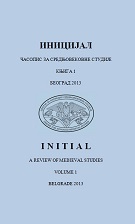Помени предака у повељама Немањића и легитимизација власти
Mentions of Ancestors in Nemanjić Charters and Legitimization of Power
Author(s): Marija VasiljevićSubject(s): History
Published by: Центар за напредне средњовековне студије
Keywords: Nemanjić dynasty; legitimacy of power; holy ancestors; charters; Middle Ages; 12th–14th century; royal ideology
Summary/Abstract: Mentions of ancestors in the charters of Serbian medieval rulers from the Nemanjić dynasty often bear an ideological note illustrating one of the key requirements of medieval government – the need to legitimize a ruler’s hold on power or, in other words, to recognize newly acquired ruling authority as legal. Analysis of these ideological mentions of ancestors has uncovered three patterns of their usage, based on the manner in which the ancestral motif is used and the degree of legitimization it achieves. The first pattern consists of mentions found in autobiographical excerpts placed in the preambles (arengae) of solemn charters recording donations to ecclesiastical institutions. In situations when his right to power is disputable, the current ruler speaks of his accession to the throne, creating a context in which he can be represented as a legitimate heir. This pattern was present in the documents of rulers whose right to the throne was questioned since the beginning of their reign – Stefan the Firstcrowned, Stefan Dečanski and Stefan Dušan. The second pattern concentrates on the mentions of ancestors as saints. This pattern’s potential for legitimization is most notably exploited in the rulers’ intitulations. Mentions of this type are often followed by the beata stirps motif which was initially linked to the metaphor of the tree of Jesse. This pattern is present in the documents of Nemanjić rulers since the time of the canonization of the dynasty’s founder, Stefan Nemanja, and its frequency testifies to the suitability of such mentions for legitimization of power. The last pattern comprises participation of the holy ancestors in government. At first, the ancestors participate in government through their mention in the sanctions of royal charters as protectors of the current ruler’s donations along with God, the Virgin, and some of the greatest Christian saints. Later, they are shown as helping the ruler in conquests or succession to the throne through their prayers. This pattern was developed during the reign of king Мilutin, at a time of severe internal conflicts. Widespread presence and constant innovation of ancestral mentions indicate that they had an important role presenting the rulers to the readers and users of their documents. Additionally, the variety of the types of mentions implies that the diplomatic image of the ruler was adjusted to the current political situation. It was of crucial importance in the tumult of frequent dynastic confrontations, which strongly encouraged the use of every available instrument to demonstrate a ruler’s legitimacy.
Journal: Иницијал. Часопис за средњовековне студије
- Issue Year: 2013
- Issue No: 1
- Page Range: 77-96
- Page Count: 20
- Language: Serbian

